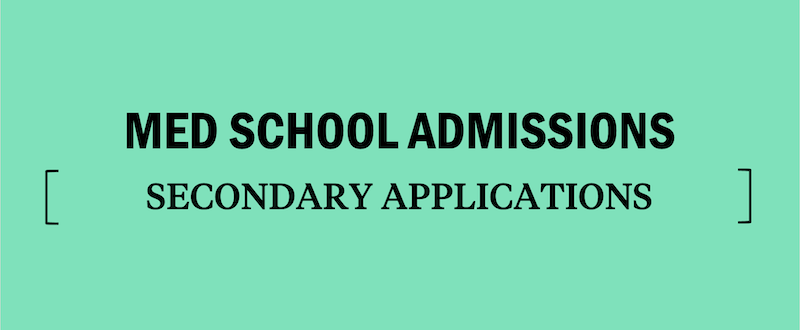Medical School Admissions: Secondary Applications
Since dominating the MCAT, everything has gone smoothly in your medical admissions journey: You’ve crafted a masterful personal statement, chosen your favorite 15 activities, meticulously entered every class you’ve ever taken, and finally hit the “submit” button on your AMCAS application.
Now it’s time to turn your attention to that growing pile of emails—no, not acceptances (just yet!), but secondary applications. These school-specific applications feature a host of essays comprising the next step on the path to medical school. As part of our continuing series on holistic review in admissions, let’s look at a few FAQs about secondaries.
What are secondary applications?
Unlike your AMCAS application—which is standard across all the medical schools you’re applying to—secondary applications are directly sent to you by each school on an individual basis. As such, they are focused on the interests of that particular school.
Secondary applications run the gamut in terms of length and involvement: Some are only a handful of yes-or-no questions, while others require up to four full-length essays. On the more annoying side of things, some secondary applications can involve 20 short answer questions and ask you to re-enter every class you’d taken that met the prerequisite criteria. However, the “average” secondary application (if there really is such a thing) has one to two short essays and asks for a bit of additional biographical or academic data.
Will I get a secondary from every school I apply to?
The short answer is: probably. Few schools turn down applicants before the secondary application stage. For the most part, an application is not really considered “complete” until the secondary has been received, and thus will not be reviewed until that point.
There is anecdotal evidence that some schools do screen before distributing secondaries, but you should expect to receive a secondary from pretty much all of the medical schools to which you apply.
How much do secondary applications cost?
This also varies from school to school, but secondary applications are about $100 apiece on average. The cheapest will run you about $30, whereas the most expensive can be $250. If you have not checked it out yet, make sure to query AAMC’s Fee Assistance Program (FAP). They can help reduce the cost of applications.
What are common questions on secondary applications?
The essay prompts and/or short answer questions you encounter will be school-specific, but here are a few common ones:
- What are you interested in?
- Why are you interested in our medical school specifically?
- How would you add to the diversity of our school?
- What is a challenging situation you’ve had to overcome?
- One is one non-medical activity that has had a significant impact on you?
- If you have already graduated, what have you done since undergrad?
Do secondary applications have deadlines?
Most medical schools’ deadlines for secondaries are in December or January; however, some schools will give you a deadline based on when you receive your secondary application. For example, it might specify that you have two weeks from receipt of the application to complete it.
Even if the deadline is not for a while, be strict with yourself in working to turn secondaries around quickly. Like all aspects of applying to medical school, getting your information in sooner is always better than later. To help with organization, try creating a spreadsheet that includes the essay topics, the due dates, the relevant websites, and the log-in information for each site. It’s super easy to mix these components up, especially if you get many secondaries back at the same time. Organization is key.
How do I write so many essays?
Even more so than the standardized AMCAS, secondary applications demand efficiency to complete multiple essay responses at once. Since “Why are you interested in our school?” is a question that appears on almost all secondary applications, choose aspects that matter to you in a medical school in general that can then be tailored to each school. In other words, you may have a common skeleton for this essay, outlining your interest in research opportunities, free student-run clinics, and a devotion to the surrounding community. You can then fill in the skeleton with specific details about each school: “[Medical school name]’s commitment to research, such as [insert significant research program at that school] piques my interest in your school.”
This adaptability of the essay is critical to being able to turn around those secondaries quickly. It is no less honest—you should only be choosing characteristics of a school that do indeed make you want to go to that school—and it gives your essays structure.
What are schools looking for in the essays?
Even if the essay is not the classic “Why our school?” question, it is critical to link your essays back to the particular school from which you got the secondary application. Cite specific examples of programs, projects, or characteristics of a school that make you a qualified candidate. Other than that, it’s all about honesty. Just like the personal statement, you want activities and achievements that speak for themselves, rather than ones that pander to what you think the admissions committee “wants to hear.”
Secondary Application Do’s and Don’ts
♦ Do make each essay specific to the prompt
♦ Do have lots of people proofread your essays
♦ Do use a spreadsheet to organize which essays go to which schools
♦ Don’t just cut and paste parts of other essays without ensuring your essay makes sense
♦ Don’t simply repeat information from primary application
♦ Don’t forget to include payment if one is required.
4 tips to manage your secondary applications
Unlike with the primary applications, secondary applications differ for every medical school. This means that each school will have a different fee, a different form, and a different set of essays.
If you’ve applied to ten or more medical schools, keeping track of all of your secondaries can seem like a challenge. With the right approach, however, you can master the process and boost your chances of landing an acceptance.






